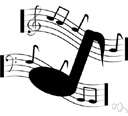
I'm sure that you have had the experience in your playing when someone asks you to play a song in a different key than the original song on the CD. Or when a singer starts to sing in the key that you are playing in and all of a sudden they start singing in a next key. (I know that has happened to me alot) This lesson focuses on piano however transposition and modulation can apply to bass and organ as well.
As a piano/organ/keyboard/bass player it's your job to know how to modulate to a different key quickly and as smooth as possible. Just to break it down modulation is just a way of getting to a new key from an old key. A good example is let's say I'm playing in the key of Ab and I want to get to B. That is an example of modulation. This idea goes hand in hand with transposition.
When I say transposition I am not refering to pressing that magical button on your keyboard that allows you to change the key. (That's a big no...no!) As a musician, you need to be able to change the key smoothly. If you don't do that it can easily ruin the flow of the music.
There are 2 ways to transpose:
1a)by intervals such as P3, M3
1b)by scale degrees (we here in the west call it the number system)
1a. Intervals: In the previous example I mentioned that we are moving from Ab to B which is a minor third. To put it easily you are going to raise all the notes in that scale a minor 3rd. Intervals can be a little more complex such as a Perfect 4th but we will keep it simple for now.
Here's the breakdown
"Eb" in the key of Ab would become "Gb (F#)" in the key of B. "C" in the key of aB would become "Eb" in the new key of B. "F" would become "Ab" and so forth. All chords would move a minor 3rd.
1b. Scale degrees: I am not big person on scale degrees because it sounds complex however for me personally I just like to refer it as the number system. Instead of refer to letters as notes. I refer to notes as numbers. Here's a short example:
In the key of C the number system are: C=1, D=2, E=3, F=4, G=5, A=6, B=7, C=8
It's the same thing as a scale degree. So the chords that you call out such as a C major chord can be referred to as C-E-G or 1-3-5 in the key of C. This system is transferable across all 12 keys. The concept can be use for instruments such as bass, keyboard, organ, piano, guitar.
You can also use the scale degrees in progressions as well such as 7-3-6 or 2-5-1 as well for example.
To put it simply, modulation means to get to a different key and one of the methods that I use that is effective is using the 5 of the 4 method. That's for a follow up lesson.
It was not easy to explain this but I hope that it was explained well enough to you. This will give you a better idea of how to transpose and modulate to other keys If you want to learn more about transposition you can see all about it through this course by clicking down below:

*Credit for image goes to author


